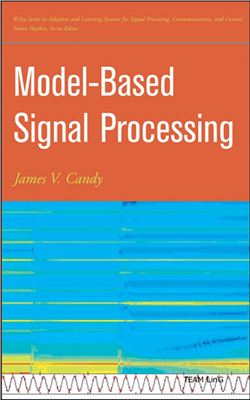Издательство John Wiley & Sons, 2006, -701 pp.
Учебник по обработке сигналов (для студентов и аспирантов). Оригинальный подход, основанный на построении моделей и процессоров для их функционирования.
This text develops the model-based approach to signal processing for a variety of useful model-sets, including what has become popularly termed physics-based models. It presents a unique viewpoint of signal processing from the model-based perspective. Although designed primarily as a graduate text, it will prove useful to practicing signal processing professionals and scientists, since a wide variety of case studies are included to demonstrate the applicability of the model-based approach to real-world problems. The prerequisite for such a text is a melding of undergraduate work in linear algebra, random processes, linear systems, and digital signal processing. It is somewhat unique in the sense that many texts cover some of its topics in piecemeal fashion. The underlying model-based approach of this text is uniformly developed and followed throughout in the algorithms, examples, applications, and case studies. It is the model-based theme, together with the developed hierarchy of physics-based models, that contributes to its uniqueness.
Introduction.
Discrete Random Signals and Systems.
Estimation Theory.
AR,MA,ARMAX, Lattice, Exponential, Wave Model-Based Processors.
Linear State-Space Model-Based Processors.
Nonlinear State-Space Model-Based Processors.
Adaptive AR,MA,ARMAX, Exponential Model-Based Processors.
Adaptive State-Space Model-Based Processors.
Applied Physics-Based Processors.
A Probability and Statistics Overview.
B SEQUENTIAL MBP and UD-FACTORIZATION.
SSPACK PC: AN INTERACTIVE MODEL-BASED PROCESSING SOFTWARE PACKAGE.
Учебник по обработке сигналов (для студентов и аспирантов). Оригинальный подход, основанный на построении моделей и процессоров для их функционирования.
This text develops the model-based approach to signal processing for a variety of useful model-sets, including what has become popularly termed physics-based models. It presents a unique viewpoint of signal processing from the model-based perspective. Although designed primarily as a graduate text, it will prove useful to practicing signal processing professionals and scientists, since a wide variety of case studies are included to demonstrate the applicability of the model-based approach to real-world problems. The prerequisite for such a text is a melding of undergraduate work in linear algebra, random processes, linear systems, and digital signal processing. It is somewhat unique in the sense that many texts cover some of its topics in piecemeal fashion. The underlying model-based approach of this text is uniformly developed and followed throughout in the algorithms, examples, applications, and case studies. It is the model-based theme, together with the developed hierarchy of physics-based models, that contributes to its uniqueness.
Introduction.
Discrete Random Signals and Systems.
Estimation Theory.
AR,MA,ARMAX, Lattice, Exponential, Wave Model-Based Processors.
Linear State-Space Model-Based Processors.
Nonlinear State-Space Model-Based Processors.
Adaptive AR,MA,ARMAX, Exponential Model-Based Processors.
Adaptive State-Space Model-Based Processors.
Applied Physics-Based Processors.
A Probability and Statistics Overview.
B SEQUENTIAL MBP and UD-FACTORIZATION.
SSPACK PC: AN INTERACTIVE MODEL-BASED PROCESSING SOFTWARE PACKAGE.

